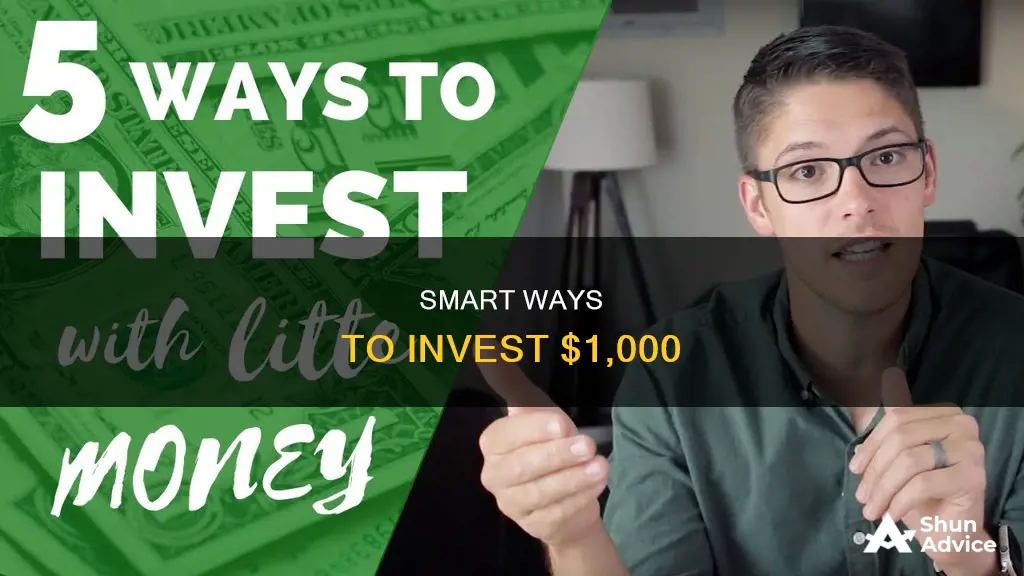
Investing $1,000 can be a great way to improve your financial situation, whether you're looking to pay off debt, save for a rainy day, or grow your wealth. Here are some options to consider:
- Pay off high-interest debt: If you're paying high-interest rates on credit card debt, for example, paying off that debt could be a wise financial decision. It can help eliminate or reduce interest charges and improve your credit score, leading to better rates and deals on loans and credit cards.
- Build an emergency fund: Having an emergency fund is crucial for your financial health. It helps you stay afloat during unexpected costs or a sudden loss of income. Aim to save three to six months' worth of living expenses in a high-yield savings account to earn a decent return.
- Contribute to a retirement account: Investing in a retirement account, such as a 401(k) or an Individual Retirement Account (IRA), is a great way to save for the long term. If your employer offers a 401(k) match, take advantage of it to get free money for your retirement savings.
- Invest in the stock market: You can invest in the stock market through a traditional brokerage account or a robo-advisor. Consider investing in an S&P 500 index fund, exchange-traded funds (ETFs), or a diverse portfolio of individual stocks.
- Open a high-yield savings account: If you want a safe and accessible option, consider putting your $1,000 in a high-yield savings account. These accounts offer competitive interest rates, and you can easily withdraw your money whenever needed.
What You'll Learn

Pay off high-interest debt
If you have $1,000 to invest, one of the best things you can do with it is to pay off any high-interest debt. This is because high-interest debt can be extremely expensive to carry and challenging to pay off. The longer you leave it unpaid, the quicker the costs grow, especially if the interest compounds daily.
Credit cards, for example, often have interest rates of 15% to 30%, and if you don't pay off your balance in full each month, most credit cards will charge high interest rates of 18% or more. If you have a high-interest credit card debt, the wisest thing to do is to pay off the balance in full as quickly as possible. Virtually no investment will give you returns to match an 18% interest rate on your credit card.
Other types of unsecured debt, such as personal loans and private student loans, also tend to have high interest rates.
If you have high-interest debt, you could consider the following strategies:
- Make more than the minimum monthly payment. Making only the minimum payment will likely cost you more in interest in the long run. Instead, aim to pay more than the minimum each month to make a larger impact on what you owe.
- Use the debt avalanche repayment method. This involves ranking your debts in order of interest rate and focusing on repaying the highest-interest debt first. Then move on to the debt with the next-highest interest rate, and so on. This method can help you save money in the long run by reducing the amount of interest you pay over time.
- Consider debt consolidation. If you have multiple sources of high-interest debt, debt consolidation can help you get a handle on what you owe. This process allows you to combine several existing debts into a single new loan, ideally with a lower interest rate and more favourable repayment terms.
Remember, when it comes to high-interest debt, consistency is key. Make it a priority to keep up with your minimum monthly payments, pay more when you can, and avoid charging new debt.
Best Etoro Investments Today
You may want to see also

Build an emergency fund
Building an emergency fund is a crucial step in achieving financial security. An emergency fund acts as a safety net, providing financial protection against unexpected expenses such as car repairs, medical bills, or job loss. Here are some detailed and instructive steps to help you build a robust emergency fund with your $1,000:
Understand the Importance of an Emergency Fund:
Unexpected financial emergencies happen to everyone, and having an emergency fund can be a lifeline during those challenging times. It ensures that you have cash readily available to cover unforeseen costs without straining your budget or falling into debt. This fund will help you maintain financial stability and give you peace of mind.
Set a Realistic Savings Goal:
The general recommendation is to save between three to six months' worth of living expenses in your emergency fund. However, the exact amount you need depends on your unique situation. Consider your monthly expenses, including rent, utilities, groceries, and any other essential costs. Calculate how much you would need to cover these expenses for three to six months, and set that as your initial savings goal.
Choose the Right Account:
Select a dedicated savings account for your emergency fund, preferably a high-yield savings account. Look for accounts that offer a competitive annual percentage yield (APY) to maximize your returns. Some accounts may have minimum balance requirements, so shop around for one that suits your needs. Ensure the account is easily accessible, allowing you to withdraw funds when necessary without incurring penalties.
Make a Savings Plan:
Commit to a consistent savings habit by setting up automatic recurring transfers from your checking account to your emergency fund. Decide on an amount that you can comfortably set aside each month and arrange for it to be transferred automatically. This way, you save effortlessly without having to remember to transfer funds manually.
Take Advantage of Windfalls:
If you receive a tax refund, bonus, or any other unexpected cash windfall, consider allocating a portion of it to your emergency fund. This strategy will help you boost your savings more rapidly.
Monitor Your Progress:
Regularly check your emergency fund balance and celebrate your savings milestones. This practice will keep you motivated and encourage you to stay on track. If you find yourself using part of the emergency fund, be sure to replenish it as soon as possible to maintain its effectiveness.
Building an emergency fund is a foundational step in achieving financial resilience. It ensures that you have the resources to handle unforeseen events without derailing your financial goals. By following these steps, you can effectively build and maintain your emergency fund, giving yourself peace of mind and financial security.
Songs: The New Investment Avenue
You may want to see also

Invest in stocks
Investing in stocks is a great way to grow your money over time. Here are some tips for investing $1000 in stocks:
Choose the Right Stocks
When selecting stocks to invest in, it's important to do your research and consider your financial goals and risk tolerance. Diversifying your portfolio by investing in various sectors, such as technology, healthcare, and renewable energy, can help mitigate risk.
Consider Exchange-Traded Funds (ETFs)
ETFs are a great option for beginners as they are easy to purchase, have lower fees than many other investment options, and can accept small deposits. The SPDR S&P 500 ETF Trust (ticker: SPY) is a popular choice for those looking for a relatively low-risk investment.
Individual Stocks
If you want more control over your investments, you can consider purchasing individual stocks. Even with $1000, you can build a well-rounded portfolio by investing in fractional shares, which allow you to buy a portion of a stock rather than a full share.
Blue-Chip Stocks
If you're looking for more established and reliable stocks, consider blue-chip stocks, which are known for their strong performance and stability. Examples of blue-chip stocks include Microsoft Corp. (MSFT), Alphabet Inc. (GOOG, GOOGL), and Amazon.com Inc. (AMZN).
Robo-Advisors
If you don't want to actively manage your investments, you can use a robo-advisor. These online services use algorithms to create a diversified portfolio based on your goals and risk tolerance. Many robo-advisors have low or no minimum opening deposits, making them accessible for those starting with $1000.
Brokerage Accounts
You can also consider opening a brokerage account, which allows you to invest in stocks, exchange-traded funds, bonds, options, and more. Brokerage accounts often offer a range of tools and amenities to help you research, trade, and manage your investments.
Remember, investing in stocks comes with risks, and there is no guarantee of returns. It's important to do your own research and consult with a financial professional before making any investment decisions.
Gamestop: The People's Stock
You may want to see also

Open a retirement account
Opening a retirement account is a great way to invest $1,000. Individual retirement accounts (IRAs) are specifically designed to help you save for retirement by offering significant tax advantages. The earlier you start, the longer your money has to grow.
There are two main types of IRAs: Traditional and Roth. The one you choose will depend on your age, income, and financial goals. For example, if you want to make tax-deductible contributions, a traditional IRA could be the right choice. On the other hand, if you want to be able to withdraw your contributions tax-free, a Roth IRA might be better suited to your needs.
When it comes to choosing a provider, several options offer IRAs with no minimum deposit, including Fidelity Investments, Merrill Edge, Charles Schwab, and TD Ameritrade. However, it's important to read the fine print, as these accounts may carry higher maintenance fees or trading commissions, and there may be requirements to make regular deposits.
If you don't have access to an employer-sponsored retirement plan, or if you've already maxed out your contributions for the year, opening an IRA is a great way to boost your retirement savings and take advantage of tax benefits.
Theft of Investments: A Growing Concern
You may want to see also

Robo-advisors
- Betterment: Betterment offers a powerful combination of goal-based tools, affordable management fees, and no account minimum. It has a wide range of investments, including socially responsible and crypto portfolios, and offers paid access to financial advisors and excellent tax strategy.
- Wealthfront: Wealthfront is our highest-scoring robo-advisor thanks to its blend of automated investment portfolios and DIY stock investing portfolios, its wide variety of account options, excellent tax strategy, and low management fee.
- Vanguard Digital Advisor: Vanguard Digital Advisor is an affordable robo-advisory service that uses Vanguard's key ETFs to create a personalized retirement plan and portfolio. However, it doesn't offer much portfolio customization or access to a human advisor.
- SoFi Automated Investing: SoFi Automated Investing offers free investment management and access to financial advisors. It has a low minimum investment amount of $1.
- Ellevest: Ellevest is committed to evening the investment playing field for women. It offers tailored investment portfolios, low-cost subscription pricing, and discounted financial advisor access.
- Fidelity Go: Fidelity Go frequently makes the list of best robo-advisors for its low fees, integration with other Fidelity accounts, and use of Fidelity Flex funds, which have no expense ratios.
When choosing a robo-advisor, consider factors such as management fees, expense ratios, account types, investments, rebalancing, and access to human advisors.
Dholera: Invest Now or Miss Out?
You may want to see also
Frequently asked questions
The best way to invest $1,000 depends on your financial situation. If you have high-interest debt, consider paying it off first. Next, focus on building an emergency fund of three to six months' worth of living expenses. If you have money left over, consider investing it in an IRA or a 401(k) to build your retirement savings.
There is no easy way to turn $1,000 into $10,000. The average stock market return is about 10% per year, so it would take 24 years to reach $10,000. You can speed up the process by adding to your original investment. For example, investing an extra $50 each month will get you to $10,000 in nine years, assuming a 10% annual return.
One of the easiest ways to double your money is to invest it in a 401(k) and get your employer's match. For example, if your employer matches your contributions dollar for dollar, you'll get a $1,000 match on your $1,000 contribution.
If you have an extra $1,000, it's better to use it to improve your financial situation rather than spending it on something you don't need. Paying down high-interest debt is a good place to start, followed by building an emergency fund. If you have any money left over, consider investing it in an IRA or a 401(k) to build your retirement savings.







